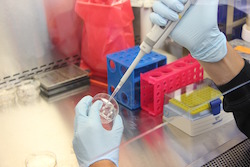
As Francis Collins and I wrote in May, NIH and NIDA are committed to an “all scientific hands on deck” effort to end the opioid crisis in America by halving the time it takes to develop new medications to treat pain and addiction and reverse overdoses. This effort will involve partnerships with pharmaceutical companies and academic institutions, leveraging the diverse benefits that federally funded science, private industry, and academia can bring to bear. Such partnerships have always been important in advancing treatment of addiction, as exemplified by NIDA’s partnership with Lightlake Therapeutics, Inc. (a partner of Adapt Pharma Limited) that led to the approval of nasal Narcan (an intranasal formulation of naloxone) in 2015.
The goals of the new initiative range from innovative and ambitious new treatment approaches that will take some time to develop, such as vaccines or transcranial magnetic stimulation for pain and addiction, to goals that are relatively achievable in the short term, such as improved formulations of existing medications. Effective medications are already available to treat opioid addiction—buprenorphine, methadone, and naltrexone—but only a fraction of people with opioid use disorders are being treated with them, due to limited access and treatment capacity, stigma around their use, lack of provider training, and cost. Also, for those treated, compliance tends to be low and few are retained in treatment for sufficient periods of time. New formulations of these medications that can facilitate access to treatment and improve compliance could be a real game-changer that could quickly make a dent in this crisis.
Buprenorphine and methadone are both highly effective at controlling cravings and withdrawal symptoms when they are administered at sufficient doses for a sufficient length of time. The reality is that these drugs are still not widely available, and are often used at too low a dose and duration when they are available. People who live in rural communities are at particular disadvantage due to logistical challenges associated with accessing treatment. During the first few weeks on the opioid partial agonist buprenorphine, the induction period, the patient must visit the doctor’s office daily or near daily while the dosage is adjusted. Even after the patient’s dosage is adjusted, he or she needs to visit the doctor regularly.
Patients face similar challenges with the opioid agonist methadone, which is only available from opioid treatment programs (OTPs) and is often not covered by insurance. In addition, some states place restrictions on the doses that can be administered or the duration of treatment. Initially, patients are required to visit their OTP daily or, as their treatment progresses, every couple of days. These restrictions are intended to prevent both diversion and overdose. (Methadone overdose is a significant risk for patients who are prescribed it for pain, whose usage is not as closely monitored.) But those who don’t live near an OTP are for this reason not able to take advantage of this medication to treat their addiction.
If extended-release formulations of these drugs were available that allowed patients to get a single injection (depot formulations)—once every few months, or even once a year—it would go a long way toward providing patients a stable, consistent dose and promoting long-term retention in treatment. Developing such formulations is one of the goals for the partnerships NIH is pursuing with industry. A little over a year ago, the FDA approved a six-month buprenorphine implant called Probuphine that Titan Pharmaceuticals had developed with support from NIDA, and this was an important first step. Its dosage is equivalent to 8mg daily, which is relatively low—most people require buprenorphine doses in the 16-24mg range—so the development of higher-dosage formulations, as well as depot injections, would be of great benefit. Multiple pharmaceutical companies are already working to develop new depot formulations of buprenorphine. Implantable formulations of methadone have been evaluated in animal models and also have the potential to be a valuable tool for the treatment of opioid addiction.
Vivitrol, an injectable version of naltrexone that blocks the effects of opioids in the body for four weeks, was approved by FDA in 2006 for treating opioid addiction. Vivitrol makes treatment compliance easier for patients who no longer need to remember to, and choose to, take a pill every day. The challenge with opioid antagonists like naltrexone is that patients have to be detoxified prior to treatment initiation to avoid withdrawal. Not all patients tolerate the transition to treatment with an opioid antagonist like Vivitrol, and research is ongoing to evaluate new strategies that can facilitate induction on such medications. Also, patients on naltrexone rapidly lose their opioid tolerance, putting them at risk of overdose if they discontinue treatment—which happens all too often due to lapses in access, insurance coverage, or compliance.
Longer-acting formulations of naltrexone or other opioid antagonists could provide greater protection against relapse and overdose, the risk of which is particularly high during the first few months of treatment. Such formulations will make it easier for patients who have difficulty with medication compliance, and thus will help prevent relapse. The benefits of depot formulations for opioid agonists and partial agonists would be just as great, and would also eliminate diversion and misuse, which are concerns with the use of immediate-release opioid medications.
Bringing an end to the opioid crisis, which continues to claim more than 91 American lives every day, is a top priority for NIDA and NIH. Some solutions are still on the drawing boards and will take many years to come to fruition. But other solutions like improved formulations of existing medications could be developed in a much shorter time frame to help the millions of Americans currently suffering with opioid addiction achieve and maintain a stable recovery. The partnerships that NIH is currently forging between government-funded institutions and private industry aim to accelerate the translation of scientific solutions to help end the opioid crisis.
